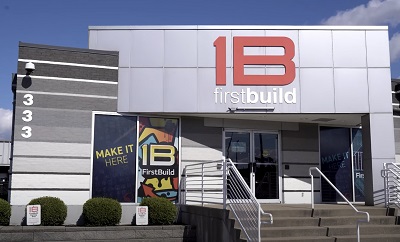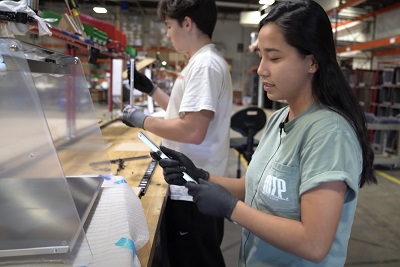NextGen manufacturing at GE Appliances
With its microfactory strategy, the appliance leader is thinking small to get big
Every now and then, you come across something that makes you look at the world a little differently. FirstBuild, GE Appliances’ microfactory strategy, is a concept that could make you think differently about how new products are created and brought to market, as well as whether mass production and economies of scale are the only way to manufacture.
Economies of scale, as we all know, holds that if you mass produce a product you can spread the cost of production across millions of units. That lowers the price you charge consumers. Unless you’re playing in the luxury market, where a select few will pay big for exclusivity, mass production is the way to take market share. The downside of that approach is that it’s difficult to introduce new products into the market that don’t appeal to a broad spectrum of the population to get scale.
With FirstBuild, GE Appliances, a Haier company, is turning economies of scale on its head. Founded in 2014 as a wholly-owned subsidiary, FirstBuild is described as “a destination for makers who are fueled by a relentless drive to create what’s next through co-creation with its community…Its microfactory, open makerspace, online community and go-to-market approaches lead to innovative products people love.”
André Zdanow, the president of FirstBuild and the executive director of small appliances and COCREATE Stamford for GE Appliances, puts it this way: “We are tasked with inventing the home of the future. To do that, we are trying to get closer to the consumer and to separate ourselves from the bureaucracy that exists in a large manufacturing company. We took ideas from the startup world, like consumer-led innovation and doing small batch manufacturing. It’s a grass roots approach from ‘wouldn’t it be cool’ to a prototype.”
He adds, “We brought the quality, safety and rigor from GE Appliances and jettisoned everything else.”
A few things set FirstBuild apart. The first is the size of the microfactory. The FirstBuild microfactory in Louisville is just 35,000 square feet in a former warehouse on the campus of the University of Louisville. A second space is going up in Stamford, Connecticut.

The Louisville microfactory is divided into four sections: They include an open community space for brainstorming and production demonstration; a makerspace for prototyping and building; a shop to fabricate components; and a microfactory where products are assembled.
The microfactory is optimized for small-batch product production. There’s not a lot of automation or injection molding in the shop. Rather, it includes hand tools, 3D printers, a CNC machine, a laser and water jets. At the microfactory stage, the emphasis is on how a product works rather than what it looks like. Local innovators and inventors who get certified on the equipment can work in the shop on their own projects.
A second characteristic is that the facility “innovates through CoCreation.” FirstBuild’s philosophy is that not every new product needs to be developed inhouse; rather, there’s a lot of innovative ideas out there among consumers if FirstBuild can just tap into them. They’re doing that in a number of ways: “We’ve worked with kickstarters and we’ve done crowd funds,” Zdanow notes. “We start a conversation on our website, on social media and in person.” One example is that FirstBuild posts videos on YouTube as products progress, which allows feedback on whether they’re on the right track.
Last, FirstBuild has a fail fast mentality. “We allow a product to get killed at any point in the iterative process,” Zdanow says. You can do that when you’re working on batches of one.

It’s easy to think of the microfactory as a science project, without the need to turn a profit. And, in the early years that was true. Today, however, FirstBuild does have an operational business model and aims to turn a profit. It is tasked with launching 12 new products a year and “graduating” one by transferring it to GEA or launching it into the market on its own. As an example, the microfactory makes some components for GEA’s Monogram brand, which is a high-end, lower-volume brand, and, during COVID the microfactory made face shields for first responders. “When GEA’s supply chain was having issues during the pandemic, we were able to step in and support the company by making components like a trim kit for microwaves,” Zdanow says.
Working with community feedback, Zdanow says that FirstBuild has successfully developed more than 86 new products or features since it was launched. Two of the notable products are the Opal Nugget Ice Maker and the Shabbos Keeper.
The Opal makes chewable, crunchable, flavor-saving nugget ice. It earned over $2.7 million on Indiegogo, a platform where entrepreneurs launch new, unconventional and clever products that solve everyday problems. It’s now available from GE Profile.
The Shabbos Keeper addresses a problem for an underserved community, in this instance the Orthodox Jewish community. Those who observe the sabbath are prohibited from performing certain activities from sunset on Friday until sundown on Saturday. During that period, they can’t cook, turn off lights or use household appliances because, say, opening and closing a refrigerator door would activate lights or sounds such as an auto-defrost turning on and off.
The Shabbos Keeper is programmed with the entire Jewish calendar and can automatically set a refrigerator to Shabbos mode each week and every Yom Tov, and then set it back to weekday mode after the sabbath. When in Shabbos mode, it fully automates the compressor, auto-defrost, lights, sensors, thermistors. That allows a person to open the refrigerator without turning on the light or making a sound that would violate the Sabbath. Launched at FirstBuild, it’s now available from ZMAN Technologies.
So, let’s go back to where we started: Mass production and economies of scale. Is that still the only way manufacturing makes sense or does the future look different? “It’s not an either/or,” argues Zdanow. “Large scale manufacturing has a role, but the future of sustainable manufacturing is not always about scale. It can be enabled by a microfactory that allows you to test and learn like a startup. It allows us to look for the new rather than leave innovation to the startup world.”
You can hear more about FirstBuild from André Zdanow at the NextGen Supply Chain Conference in Chicago, October 16 - 18, 2023.










